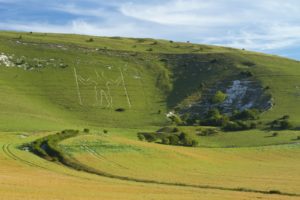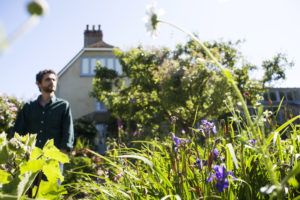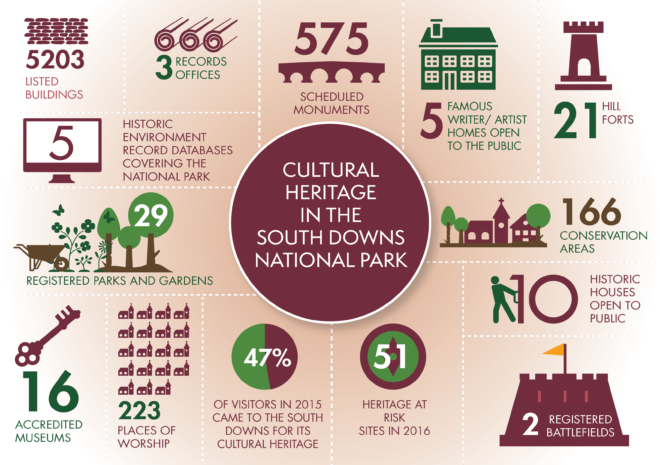Outcome 4: Arts and Heritage
Cultural heritage of the National Park is enhanced and widely understood and enjoyed.
-
-
- WHY IS IT IMPORTANT?
The cultural heritage of the National Park charts the history of inspirational landscapes and buildings that have evolved through human activity and continues to contribute to our sense of place.
Cultural heritage is not static, and change comes with both threats (such as climate change) and opportunities (such as digital technologies).
Its unique value is in helping us to engage with the present, by understanding our human journey.
Cultural heritage does not exist in isolation, but is intimately tied to how we have used, adapted and valued landscapes and places − their character, natural resources, biodiversity, built forms, views and vistas.
The value of culture was outlined in the DCMS Culture White Paper (2016):
- The intrinsic value: Culture creates inspiration, enriches lives and improves our outlook on life.
- The social value: Culture has important social benefits in terms of health, education and community cohesion.
- The economic value: the contribution culture makes to economic growth.
In the National Park, aspects of our cultural heritage have been protected by using designated protections, such as scheduled monuments, listed buildings, designated conservation areas or registered parks and gardens.
But in a landscape with such a long history of settlement, our understanding of the past is continually growing and changing, with new sites still being discovered, and new technologies revealing hidden stories.
Cultural heritage in the National Park is being actively used to inspire new audiences about its special landscapes, and the landscapes, in turn, are continuing to inspire creativity.
- WHY IS IT IMPORTANT?
For this outcome our priorities for the next five years are:
-
-
-
- 4.1 CONSERVE HERITAGE
To increase conservation, awareness, access to and understanding of South Downs cultural heritage.
Cultural heritage in the National Park is intrinsically linked to the natural environment, and contributes to it.
It is threatened by similar factors to those which affect species and habitats, and our heritage assets need to be actively looked after to ensure they survive for future generations.
It is important to ensure that the skills needed to maintain them are not lost.
The role of cultural heritage in facilitating health, wellbeing, engagement and inclusion is widely recognised.
In the South Downs it is also a key contributor to local business and tourist economies, making some cultural heritage projects a sound economic investment.
However, there are significant challenges around diminishing funding, skills and resources, and threats to preservation and conservation from climate change and land management, heritage crime, large-scale infrastructure projects and
development pressures.The projects in this Plan balance conservation and preservation with access and engagement:
- To protect and conserve we will:
− monitor, record and conserve Heritage at Risk and related vulnerable sites, structures and buildings that contribute to the Park’s special character;
− promote awareness of heritage crime and its impact, encouraging public
encouraging public custodianship of heritage assets;
− develop partnerships, projects and research, on heritage protection and
adaptation in the context of climate change;
− support joint initiatives, including apprenticeships and mentoring, which address skills loss or increase expertise and capacity to deliver conservation and access to cultural heritage; and
− increase investment in the protection and interpretation of cultural heritage through use of Section 106 and Community Infrastructure Levy money, where appropriate and relevant. - To increase access and understanding we will:
− support initiatives that increase awareness of, and engagement with, culture and heritage;
− support projects that increase knowledge and understanding of our cultural heritage;
− develop and promote the contribution of cultural heritage engagement to health and wellbeing;
− collaborate with volunteer providers to shape the next generation of ambassadors for cultural heritage in the South Downs;
− foster engagement between museums, galleries, libraries and archives holding collections relating to the history of the South Downs to develop projects and initiatives that increase our understanding, and which engage the public; and
− build stronger collaboration between a broad range of cultural heritage
organisations from in and around the National Park and its immediate
environs by encouraging cultural heritage organisations to join the South Downs Volunteering Network.
Example: Scheduled Monuments Monitoring Project
 Scheduled Monuments are recognised as nationally significant archaeological sites, and scheduling is a commitment to hand on these heritage assets to future generations.
Scheduled Monuments are recognised as nationally significant archaeological sites, and scheduling is a commitment to hand on these heritage assets to future generations.The National Park has 589 Scheduled Monuments, and currently 7% are
considered to be “At Risk”.Using lessons-learned from a 2018 pilot project, the Authority and its Ranger team will liaise with Historic England, with County and District Archaeology Officers and the National Park Ranger teams to develop a new sustainable delivery model for monitoring and recording these important sites, with a programme of condition monitoring, conservation and repairs to Scheduled Monuments accessible by the Park Ranger teams.
The innovative project will also incorporate training for volunteers and create resources and interpretation to support public engagement with these important heritage assets.
- To protect and conserve we will:
- 4.2 PROMOTE CONTEMPORARY ARTS AND CRAFTS
To promote creativity and understanding of the landscape and traditions of the South Downs through contemporary arts and crafts.
The National Park has a rich heritage of art, music and rural traditions. There is a strong association with writers, poets, musicians and artists who have captured the essence of this most English of landscapes, and drawn inspiration from its special qualities and sense of place:
Virginia Woolf, Jane Austen, Hilaire Belloc, Edward Thomas, Gilbert White, Edward Elgar, Joseph Turner, Eric Gill and Eric Ravilious, among many others.
Today, traditions continue through activities such as folk singing and events like Findon Sheep Fair. Intangible cultural heritage − such as oral traditions, festivals and traditional practices − provides fragile but emotive links to our ancestors.
The culture of the National Park is also continually renewed. New art and creative expression which is inspired by landscapes, while continuing to celebrate the strong traditions of the past.
The Authority will develop a strategic relationship with Arts Council England to support, nurture and disseminate creative practice across the arts, libraries and museums.
We will encourage this by:
- encouraging participatory events with artists/practitioners inspired by the South Downs, which empower participants to create;
- supporting a diverse range of artists and arts organisations, to respond creatively to the National Park;
- encouraging the use of traditional skills and crafts as inspiration for contemporary artistic responses to the South Downs landscapes,
wildlife and history; - promoting a wide range of the 50 or more festivals active in the South Downs, promoting creativity inspired by its landscapes, wildlife and history, and engaging wider audiences.
Example: Cultural Heritage Health and Wellbeing Mapping
 Museums, galleries, libraries and archives in and around the South Downs are delivering work that benefits communities, and, in particular, can improve health and wellbeing.
Museums, galleries, libraries and archives in and around the South Downs are delivering work that benefits communities, and, in particular, can improve health and wellbeing.From dementia-friendly reminiscence sessions to craft café’s addressing
loneliness and isolation, their collections are supporting creative processes and engagement.Nationally, it is hard to evaluate the benefits of these activities, and many activities occur outside of social prescribing frameworks.
The Authority will act as a broker to strengthen health and wellbeing delivery, and so help support more heritage organisations to engage with social prescribing. This will bring community wellbeing and health benefits as well as access to funding and networks.
A commissioned research piece will help us to connect heritage sites with social prescribing, and to create networks of activity within the National Park and its environs.
- 4.1 CONSERVE HERITAGE

-
-
-
